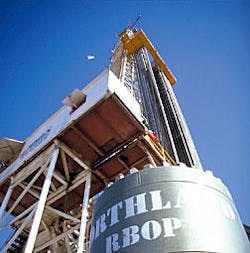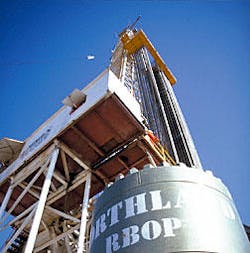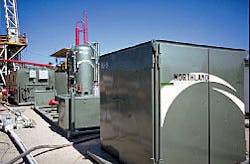Underbalanced drilling driven by success
Underbalanced drilling (UBD) operations maintain the net pressure exerted by drilling fluids in the annular space between the drillstring and the formation being drilled at values less than the formation pore pressure, as explained by D. Brant Bennion and F. Brent Thomas of Hycal Energy Research Laboratories Ltd., Aberdeen.
The authors presented their paper on evaluating reservoir performance improvements from underbalanced drilling operations at the International Association of Drilling Contractors (IADC) Underbalanced Technology Conference and Exhibition in November in Aberdeen.
The resulting pressure imbalance allows oil, water, or gas in the reservoir pore space to flow into the wellbore, returning to the surface along with the circulating drilling fluid.
The authors pointed out that, executed correctly, UBD improves well productivity, drilling performance, and reservoir understanding. They also high light some of the most common motivations for an operator to implement underbalanced operations.
- Preventing invasive drilling mud solids and fluids from causing near wellbore formation skin damage increases production rates and can remove the need for costly completion and stimulation operations.
- Lower bottom hole pressure and other dynamics of the drilling process increase drilling rate of penetration and can even lower drilling costs.
- Lower wellbore pressure of underbalanced operations reduces lost circulation problems, high torque and drag, and differential sticking.
- Continuous flow measurement provides instantaneous indication of the drill bit penetrating productive intervals.
- Underbalanced operations flush produced reservoir fluids from the wellbore, during drilling operations, for recovery and sale.
The authors explain that ideally, the formation-to-wellbore pressure imbalance should exist in every interval of viable reservoir pay zone, during the entire drilling operation, to maximize the benefits of underbalanced drilling.
Mark Bly, business unit leader of southern North Sea for BP PLC, presented data during the conference highlighting that although wells with horizontal completions make up only 8% of the well count in the southern North Sea, they account for 25% of the production.
Also according to Bly's data, the actual productivity index (PI) average for existing horizontal wells is only 40% of the theoretical PI, due to formation damage effects.
This implies that performance potential exists, which could yield 30% reserve growth and 2.5 times initial production rate from UBD and underbalanced operations.
Candidate selection
Ali A. Garrouch and Haitham M.S. Lababidi from Kuwait University presented a paper on their work to develop a system for determining whether an operator should drill underbalanced or overbalanced.
The system uses a screening procedure to account for wellbore geometry, drilling conditions, minimum rock formation damage, wellbore stability, and type of fluid influx.
An operator can use known facts to judge the reservoir's susceptibility to damage from clay swelling, fines migration, and scale deposition.
Advanced rock-mechanics models assess wellbore stability and calculate minimum drilling-fluid density to maintain wellbore integrity and prevent collapse.
The authors point out that underbalanced drilling is not a solution to resolve all formation damage issues. They say that damage caused by poorly designed or executed UBD programs can exceed that which may occur with well-designed conventional overbalanced drilling programs.
The authors say that downsides and damage mechanisms associated with UBD can include increased cost and safety concerns, difficulty maintaining a continuous underbalanced condition, spontaneous imbibition and countercurrent imbibition effects, and mechanically induced wellbore damage, such as glazing and mashing.
Flow modeling
S. P. Smith of Neotechnology Consultants Ltd., A. Steiner and S. B. Sephton of Northland-Norward Energy Services presented one of several papers on underbalanced drilling flow modeling.
The authors point out that successful completion of UBD operations depends on the accuracy of the hydraulic model used in developing the job's program. Flow behavior that deviates from the planned and expected behavior can jeopardize the job success.
Confidence in a flow model requires that the job planners examine previous cases and compare actual drilling data with the design calculations. The comparison provides insight into when the model is accurate and when the operator must use caution in interpreting the results.
In the process of reviewing a number of case histories, the authors highlighted the reason for differences between preliminary model results and field data, as well as recommendations for appropriate technology to improve the models.
Direct comparison
In another paper, T.M. Haselton and R. Kirvelis of UAB Minijos Nafta, G. Pia of Weatherford International Inc. and T. Fuller of Weatherford (UK) Ltd. presented the experiences of drilling and completing wells in the Gargdzai region of western Lithuania, which allowed direct comparison between overbalanced and underbalanced drilling and completion operations.
Wells that had been drilled with use of conventional overbalanced drilling were highly susceptible to mud-invasion damage; exhibiting skin factors in the range 70-100.
The low porosity (up to 12%) and permeability (0.1-0.5 md) of the Middle Cambrian sandstone reservoir clearly indicated susceptibility to mud-invasion damage.
Further aggravating the problem, with the reservoir in a highly depleted condition, any significant overbalance pressure during drilling has a detrimental effect on the near-wellbore reservoir rock matrix.
The operator embarked on a new drilling campaign in 2000, intent on minimizing formation damage with use of UBD methods.
The authors say the first three underbalance wells, drilled in the Pietu Siupariai field, had initial production rates that were 30 times greater than those achieved with conventional overbalanced drilling.
A 2001 exploration well in the area called the Aisenai-1 (AS-1), which was drilled in a unique fashion, highlighted dramatic improvement in productivity from underbalanced operations.
The authors say the well was drilled conventionally, or overbalanced, through the reservoir at a 45° angle, with use of a low-solids designer fluid as low-invasion mud when used in overbalanced drilling. The well produced 55 b/d during an openhole drillstem test, from the entire reservoir section.
Minijos Nafta plugged the well back with cement and drilled a second leg at 180° orientation from the first.
The rig drilled the new leg underbalanced, with use of dead crude oil as drilling fluid.
Upon completion, the well produced 2,000 b/d, which the authors say is one of the most prolific wells in Lithuania.
Production steering
When drilling the first underbalanced Pietu Siupariai field well (PS-2), Minijos Nafta displaced the well to dead crude after setting the 7-in. casing and drilled ahead into the upper reservoir section, which was not expected to produce.
The authors say that drilling had to be suspended due to a large influx of oil and upon running the completion, the well produced at an initial production rate of 4,000 b/d.
"The upper reservoir section, which produced so prolifically in this well when drilled underbalanced, had typically been drilled through without detection during conventional drilling because of the high mud weights used," say the authors.
While this example is not considered production steering, it does highlight the value of UBD in providing reservoir insight and understanding.
The operator drilled the AS-1 well horizontal lateral with use of measurement-while-drilling (MWD) data and fluid inflow monitoring and measurement.
The authors say the process of production steering can enable the drill ing process to locate the "sweet spot" or most productive zone in the reservoir, requiring only basic MWD and an underbalanced drilling separation system.
The MWD gamma ray locates the formation tops, while productivity and derived PI results from the ability to measure production in real time.
The authors highlight the productivity contrast between the overbalanced and underbalanced legs of the well.
The calculated productivity index of 3.50 cu m/d/bar for the underbalanced leg provides striking contrast to the 0.032 cu m/d/bar for the overbalanced leg.
The authors say the results offer proof that UBD can be effective, even in wells and reservoirs that appear to offer less than optimal applications. They also say the direct comparison performed in the AS-1 Lithuania well is probably an industry first.


